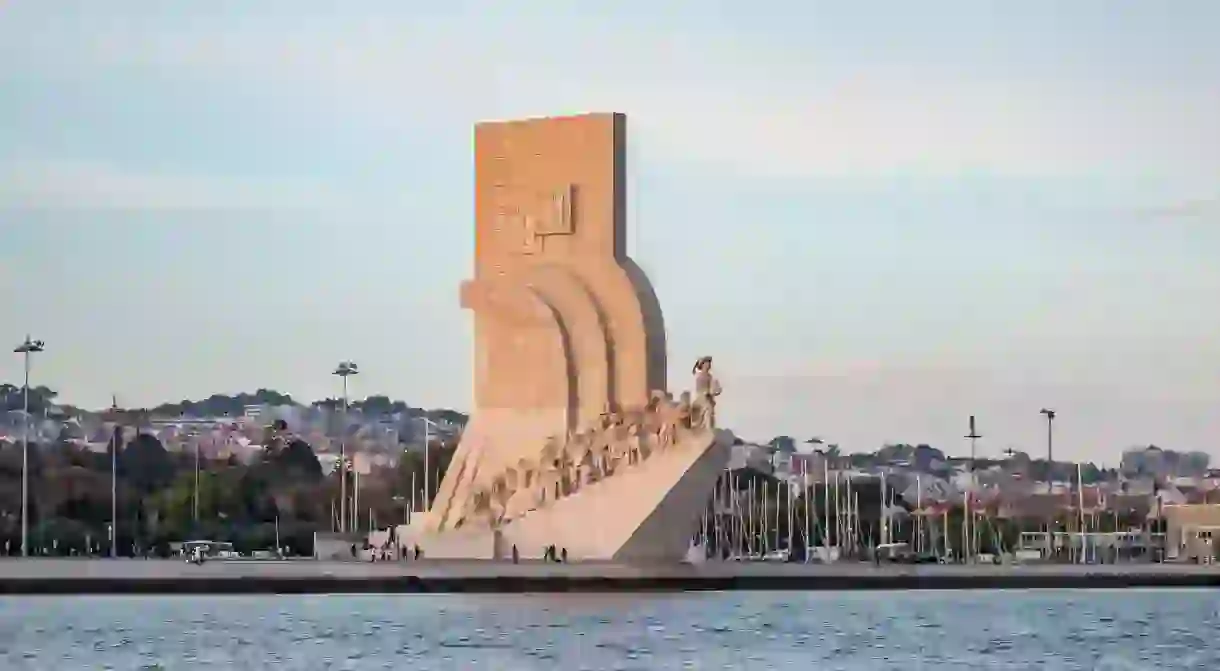An Architectural Tour of Belém, Lisbon

Take a trip back to the Age of Discovery on this architectural walking tour of Lisbon’s riverside Belém district, where the lure of the sea is tangible to this day.
When great navigators set sail in caravels from Lisbon in the 15th century, they returned with magnificent riches from newly collected colonial lands to fill the royal coffers. Today, this golden age of exploration is still beautifully mapped out in the pale limestone buildings of Belém to the west of Lisbon, where the River Tagus broadens to meet the wave-lashed Atlantic.
With its mighty monastery and fortress, this neighbourhood was the showpiece of King Manuel I, the namesake of the whimsical and exuberant Gothic style known as Manueline. Exploring the area on foot takes you to landmarks that will catapult you back to those glory days of discovery, as well as to a clutch of contemporary architectural icons.

Getting there
The most atmospheric way to reach Belém is by taking tram 15 from Praça da Figueira to Altinho. Alternatively, take the train from Cais do Sodré to Belém. Both stops are very close to the starting point of the walk. Allow at least half a day to do the walk justice, and longer if you plan on visiting all the stops on the way in depth.
MAAT
Museum

Cordoaria Nacional
Architectural Landmark

Crossing over to the other side of Avenida da Índia and detouring slightly east, you’ll notice the lemon-fronted facade of the Cordoaria Nacional, built in the 18th-century Pombaline architectural style. Opened in 1779, this was once a rope-making factory for the Portuguese navy. It now hosts rotating exhibitions. Turn the corner to see the Chafariz da Junqueira (Rua da Junqueira), an ornate early 19th-century fountain tiled in colourful azulejo panels and featuring an armillary sphere with the royal coat of arms.
Museu Nacional dos Coches
Museum

Stroll west along the Avenida da Índia and your attention will be drawn to the National Coach Museum, which straddles two startlingly different buildings. The first is the ornate former royal riding stables of Belém, built in the late 18th century following the Neoclassical designs of Italian architect Giacomo Azzolini, its interior embellished with stucco, frescoes and azulejo (decorative tile) panels. The second is its 2015 sidekick, a light-flooded, streamlined, ultra-contemporary white concrete structure that bears the hallmark of Pritzker Architecture Prize-winning Brazilian architect Paulo Mendes da Rocha. Together, these make a brave yet harmonious connection between Lisbon, old and new. The museum houses the largest collection of coaches in the world.
Belém Palace
Museum

Mosteiro dos Jerónimos
Bakery, Portuguese

Follow Rua de Belém west, stopping en route at Pastéis de Belém for a cheeky pastel de Belém custard tart (this historic bakery has been making the best since 1837), before arriving at Belém’s architectural crowning glory: Jerónimos Monastery. This UNESCO World Heritage Site is a shining example of the Manueline style, built to celebrate Vasco da Gama’s inaugural voyage to India in 1498. The cloisters brim with delicate stonework details that nod to those seafaring triumphs, with a riot of shell-shaped turrets, arches like twisted rope and motifs like the armillary sphere. Be sure to also visit the refectory to glimpse azulejo panels depicting the biblical miracle of the loaves and fishes, and the richly ornamented church with its weblike rib-vaulting. Part of the complex also shelters the Museu de Marinha, providing deeper insight into the Age of Discovery with model ships, maps and navigation instruments.
Centro Cultural de Belém
Architectural Landmark, Art Gallery, Theater

It might be hewn from the same rustic limestone as the monastery just opposite, but in all other respects the Centro Cultural de Belém is its architectural antithesis. Designed as a city in microcosm, with courtyards, squares, bridges and gardens, the clean-lined, light-drenched cultural complex raised a few critical eyebrows when it opened in 1993. Designed by architects Vittorio Gregotti (Italy) and Manuel Salgado (Portugal), it brings together concert halls, conference and exhibition centres and the outstanding Berardo Collection of modern and contemporary art. Head up to Topo terrace for drinks with cracking river views.
Padrão dos Descobrimentos
Architectural Landmark

Museu de Arte Popular
Art Gallery, Museum

Just a few steps west along the riverfront brings you to the Museu de Arte Popular (Museum of Popular Art, Avenida de Brasília). This throwback to the 1940s Portuguese World Exhibition was built to showcase the folk culture of the country’s different regions. The facade interweaves modern and traditional elements, with lattice-like arched windows and bas-reliefs with rural themes.
Sacadura Cabral and Gago Coutinho Monument
Memorial

On the other side of the Doca de Bom Sucesso, you’ll spy a seaplane monument, which pays homage to Portuguese aviation pioneer Artur de Sacadura Cabral and his sidekick Gago Coutinho, who made the first successful flight across the South Atlantic, from Lisbon to Rio de Janeiro in Brazil. The turbulent 8,400-kilometre (5,220-mile) journey took them 79 days, and the pair have been national legends ever since.
Torre de Belém
Monastery, Building, Architectural Landmark, Historical Landmark














